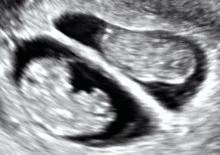This article needs additional citations for verification. (July 2010) |

Echogenicity (sometimes as echogenecity) or echogeneity is the ability to bounce an echo, e.g. return the signal in medical ultrasound examinations. In other words, echogenicity is higher when the surface bouncing the sound echo reflects increased sound waves. Tissues that have higher echogenicity are called "hyperechoic" and are usually represented with lighter colors on images in medical ultrasonography. In contrast, tissues with lower echogenicity are called "hypoechoic" and are usually represented with darker colors. Areas that lack echogenicity are called "anechoic" and are usually displayed as completely dark.[1]
- ^ Ihnatsenka, Barys; Boezaart, André Pierre (2010). "Ultrasound: Basic understanding and learning the language". International Journal of Shoulder Surgery. 4 (3): 55–62. doi:10.4103/0973-6042.76960. PMC 3063344. PMID 21472065.